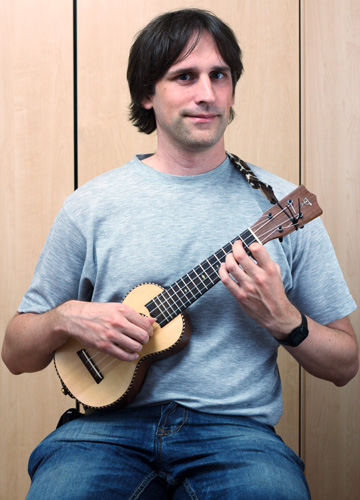Posture
What defines a proper body posture for playing an instrument?
Properties of a good posture are:
- It should be relaxed.
- It prevents prevents injuries of the musculoskeletal system.
- It eases the motion sequences of playing.
- It helps to firmly hold the instrument in place.
Since the ukulele (still) isn’t an academic instrument, I don’t know any scientific studies about body posture for playing the ukulele. However, in practice the following postures proved to be practical:
Playing while standing without strap
The ukulele is held by the right forearm as well as with the left hand. The trick is that both can hold the ukulele alone — so this task is continuously re-assigned during play. Some players like e.g. James Hill perfected this technique, the ukulele seems to stay in place by “magic”, though the left and right hand have a lot of mobility. It takes quite some practice to master this posture.
Playing while sitting without strap
When sitting, the ukulele can be stabilized by placing it on the right upper leg. Sometimes I am doing this when I’m too lazy to equip an ukulele with a strap. However, in the long run, I regard this posture as disadvantageous.
Using a strap
Some ukulele players seem to be embarrassed by using a strap. However, a strap is a very effective means for holding an ukulele in a safe and stable way, thus helping relaxed play and mobility of the hands. Therefore I recommend using a strap. I personally like magnetic straps, which can be used with ukuleles which don’t have an end pin. So almost every ukulele can be played with a strap without having to modify it.
General Advice
The neck should point upwards at an angle of 30 to 40 degrees, so the left hand can comfortably reach the whole fretboard. Therefore, the strap length has to be adjusted to be relatively short. The ukulele should be aligned so that the sound hole points forwards, not upwards. The normal position for the thumb of the left hand is behind the neck, and for the other fingers far above the fingerboard, allowing for maximum freedom of movement. When fretting, the fingers of the left hand should be placed almost perpendicularly on the fret board, so they won’t interfere with each other. This way, even the D major chord can easily be fretted with 3 fingers (which some players seem to consider as difficult).
Don’t use more force as necessary when fretting. By no means the strings should be pressed down to the surface of the fretboard. And always make sure not to tense up. Looseness is what you want to achieve, and it will show in the sound of your playing. Besides, if you play tensed up, you risk getting injuries like tendonitis.
The right forearm gently presses the ukulele against your body and helps to stabilize it. This way, you still can strum with a movement coming from the wrist. For picking, the right hand is held freely in the area between the sound hole and the 12th fret, so the fingers can be moved freely and loosely. I advise against putting the small finger on the sound board (or even worse: holding the ukulele with the right hand), since this compromises the freedom of movement and the looseness of the right hand.


 English
English  Deutsch
Deutsch